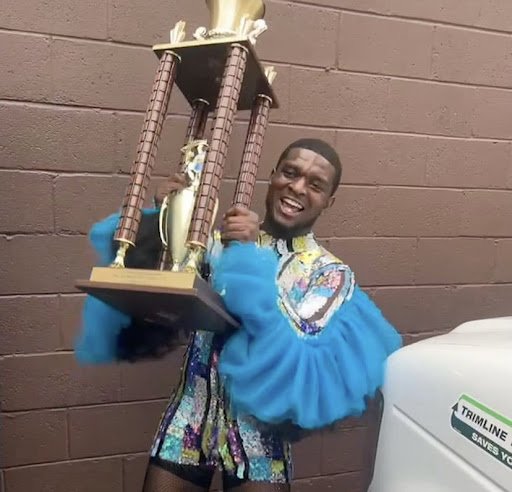My journey to finding the heart of Philly’s Black and Queer culture
(Photo of Zayah Fall)
As a young, Black, queer person, I was initially drawn to the Gayborhood's rainbow-covered sidewalks and street signs, which signaled diversity and acceptance. However, I soon realized that I was yearning for something deeper than the superficial trappings of the neighborhood.
After wandering into one of the oldest shops in the Gayborhood, I learned about the area's history and how it used to be where Black and Brown Queer and Trans people congregated before its gentrification. This inspired me to connect with other folks who had experienced gentrification firsthand, including Najee Gibson, a Trans artist and fashion designer who shared what the neighborhood was like 40 years ago.
“There was no boring moment on 13th street,” Najee Gibson, a Trans artist and fashion designer, told me on the phone while describing what the neighborhood was like 40 years ago.
Imagine sitting outside Woody’s cafe, drinking an espresso, listening to “real” House music, and perusing the shops for a scandalous souvenir. It was home to the “girls” (Trans Women) and “butch queens” (feminine Gay Men) of the town, rejected by society and who fought for adequate access to healthcare and housing. That’s what Gibson said the neighborhood was like.
Despite the Gayborhood's rich history, some Trans youth who grew up in Philly still struggle to find a safe space in the city. Alexandria Nyx, a friend from college, explained how she experienced housing insecurity and trauma in the city as a Black Trans femme.
She says: “All of my trauma happened here. There’s been more bad than good in this city, so I’ve never felt comfortable here,” she continued, explaining her experience as a Black Trans femme.
A 2022 report from the Trevor Project highlights the higher rates of homelessness and housing instability reported by Trans and non-binary youth compared to cisgender LGBQ youth, with 38% of Trans girls/women, 39% of Trans boys/men and 35% of non-binary youth, compared to 23% of cisgender LGBQ youth.
“So yeah, Philly... I’ve never felt super connected to it, but also to that point, it’s made me,” Nyx said. “I found myself in these streets.”
(Photo of Zyah Fall)
However, I also spoke with Zyah Fall, a Black Trans woman who shared similar sentiments as Nyx.
“A lot of queer and Trans spaces, consciously or subconsciously, are catered to white people,” she said. “A lot of queer and Trans spaces would be like ‘we are queer and trans centered,’ and it’s usually white enby (non-binary) and Trans-masc centered and filled with misogyny.”
That is until she found a safe space in The Attic, a youth center that offers programs and services for LGBTQ youth like life skills, mental health counseling, support services, and more. She also highlighted her experience in the Ballroom scene, which emerged during the Harlem Renaissance as a response to efforts to expel LGBTQ residents from neighborhoods.
Fall says that Ballroom is a place where “radical personhood” can be explored.
(Photo of Jahad Martin)
Ballroom culture centers on community and kinship and is led by mothers and fathers of the "house." Legendary figures in the Ballroom scene often engage in community work, such as working at HIV/AIDS clinics and throwing Kiki Balls to make space for the new generation of Ballroom kids to showcase their talent.
Particularly within the last year, artists such as Beyoncé, Megan Thee Stallion, and Kelela have explored House and Ballroom style music in their new album releases. Philadelphia has a vibrant Ballroom scene and culture that was recently displayed in the Pride Parade ball thrown by Jacen Bowman, where Ballroom performers such as Jahad Martin, Rylee Prodigy, and Makaylah Lanvin performed.
“Ballroom changed my whole aura,” Martin told me at Cafe Walnut over sandwiches. Martin said he started Ballroom when he was just 15 years old. He learned about it from a friend in the I Am a Role Model youth program, which empowers youth through fashion.
(Photo of Jahad Martin with a trophy)
“My first place to know about any Ball was The Attic,” Martin said. His experience in the Ballroom started elevating when he was around sixteen. “I was really walking. I was going to Baltimore. I was going to Jersey. Little ol’ me couldn’t even get into any clubs.”
Black Queer people often grow up being what Beyoncè references as “one of one, the only one” in non-Queer spaces. Once introduced to Ballroom, they are pushed into a complex network of Black Queer peers and elders that can offer them companionship and advice on navigating the world. Having a “Mother” or “Father” (the heads of the house) puts you in contact with everyone who is related to them, and this offers a great deal of care that a young Queer person can access outside of their biological family and traditional schooling.
This model highlights what I was truly missing in the opening of this text – the existence of Black and queer spaces.
In the erasure of these spaces, Ballroom and The Attic showcases the potential of these spaces and what young, queer people yearn for: a space to be in a community with people who share similar experiences. A space where Legend Jahad Martin says you "[shouldn’t] be nothing else, [but] you... The authentic you."




